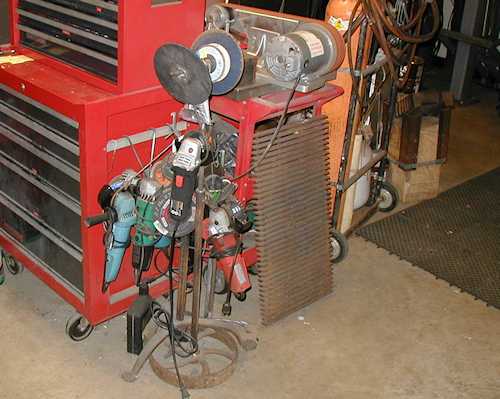A Little About Angle Grinders
Created: September 7, 2017
Last Revised: October 17, 2023

Home
Back to Spindle Adapter
My Machine Shop
Hole Tapping Tips
Blacksmithing
Contact Us
Here's a basic question that I received recently:
Debbie asks:
I am new to angle grinders. What does it mean when you say: 5/8"-11 spindle thread or 10 x 1.25 spindle thread?
Thank you for your courtesy and assistance.
-------------------------------------------------------------------------------------------------------------------
Hello Debbie.
These days, many people think of the common "4 1/2" Angle Grinder" first, but there are many other sizes.
The "4 1/2" is the outer diameter of the largest disk that will fit on the grinder.
There are also 4 inch, 7 inch, 9 inch and even 14 inch angle grinders out there in the world of cutting, grinding and polishing.
The shaft that sticks out of the end of the angle grinder at a 90 degree angle is the "spindle".
The spindle is the part that you attach the grinding disc or cutting disk to. The spindle is powered by the unit's drive motor.
This spindle is threaded on its outboard end.
Some of the abrasive disks simply drop onto the spindle and a special threaded nut is used to hold the disk in place during use.
In some cases, this special nut has a couple of flanges that allow it to adapt to either 5/8" or 7/8" holes in the disk.
Other disks are threaded themselves and they simply screw onto the threads of the spindle.
The diameter of the holes in the disks and the thread size and pitch (number of threads per inch, for example) must match the spindle,
as you can well imagine.
The problem for us users is when we see a disk whose grit (coarseness) or style (cutting vs grinding) is what we want,
but the disk doesn't fit our angle grinder's spindle.
So we need to know what size and thread our angle grinder's spindle really is when selecting a disk.
And, of course, that's what my spindle adapter webpage is about-
Adapting the spindle from a small "foreign" size to the American size, so we can have a wider choice of abrasives.
-----------------------------------------------------
=======================================================================
Note about "wheels" for angle grinders:
There are many kinds of wheels for angle grinders these days.
Everything from flap sanding disks, to simple abrasive disks to wire wheels to actual grinding wheels and on and on.
One of the more interesting, to me, accessories for the Angle Grinder is the cutoff wheel. Not that they are anything new.
But, over the last few years, I have seen many, many people begin using the angle grinder with a cutoff wheel as their main steel cutting tool.
I even saw one guy make a small blacksmith anvil from a section of railroad rail, using a cutoff wheel on his angle grinder to profile it.
I'll bet he spent 6 or 8 hours at a minimum to do all the required cutting!
Cutoff Wheels generally wear out pretty quickly, so if you plan to use them, be sure to get plenty of them!!!
=======================================================================
I found this general explanation about spindles on the "net" just now (and added a couple of words):
----------------------------------------------------------------------------------------------------
"The "standard" spindle (sometimes called the "arbor") thread these days on a angle grinder in the US is 5/8-11 (5/8" diameter and 11
threads per inch). There are a couple grinders that use a metric thread M10 (10 millimeters in diameter, with a couple of different
thread pitches, for example: 1.25 millimeters (between thread crowns) or M14, but these are pretty rare.
A few smaller grinders and most pneumatic models use a 3/8"-24 arbor.
It sounds confusing, but the good news is none of it really matters for the most part. Usually when you see a wheel listed as 7/8 bore,
it will fit on just about any non-air operated grinder, when you use the nut to hold it on to the shoulder.
A wheel listed as 5/8" will also fit most grinders, as those usually thread on the arbor."
----------------------------------------------------------------------------------------------------
While the above article is generally true, the author fails to recognize that we in the USA import LOTS of angle grinders and they
often DO have those smaller diameter spindles AND with metric threads.
Here's my answer to adapting those smaller spindles as needed:
Pete's Angle Grinder Spindle Adapter Ideas
Moral of the story:
If you are considering buying one of these tools, feel free to MAKE the salesperson tell you about the availability and range of
disks for the grinder you want to buy.
One of the best places to go to find well informed sales people is your local welding supplies dealer.

